There is a fix for the condensation build up in the intercooler!
#2101
International man of Myst
In my experience, some of the least reliable information about future products comes from the very people that work for those companies. In fact, I've seen several people straight up "officially confirm" information that was clearly incorrect. I've been promised **** will by X by date so and so, then it shows up as Y and I'm irrevocably ****ed. And this is more than just automotive related stuff, industrial controls, power system equipment, etc, until it's in front of me or can be ordered, it's wild speculation.
Basically, I'll believe it when I see it.
Basically, I'll believe it when I see it.
The following 3 users liked this post by LastResort:
#2102
Evil. Big. Oil.
Well...
First off I would like to apologize to anyone whom I doubted last year (or two) regarding the "Ecoboost humidity/dewpiont/deathtrap issues". Sorry.
I never doubted things were wrong, I just never knew how bad they were. See old thread...https://www.f150forum.com/f70/ecoboo...nigans-163764/
Long story short, I had the issue. Dealer "fixed it". Fast forward 40k and I have it again. Dealer "fixed it". Fast forward 30k to last week, I have the issue again. Dealer installed TSB 13-8-1, which, from what I understand is a piece of foam tape stuck to my CAC...apparently designed to make the intercooler 1/3rd as efficient? (And to think it only cost me $140 dollars to have them install it!)
Brilliant Ford.
Oh! Oh! I have the next Ecoboost TSB! # 14-1-1, remove both Turbos! Problem solved.
Honestly, I have nothing of value to add here. I just wanted to rant. While my truck was getting "fixed" I drove a loaner 5.0 F-150 with 80k...the same miles as my truck. It has more power than my now nerfed EB. It wouldn't be so bad..except I seem to remember paying like an extra $1000 for the Ecoboost option?
I'm going back into the dealer tomorrow. Unless they make me a great deal on a 5.0, this will be my last Ford...which is sad, because until recently I've been really happy with all my Fords.
First off I would like to apologize to anyone whom I doubted last year (or two) regarding the "Ecoboost humidity/dewpiont/deathtrap issues". Sorry.
I never doubted things were wrong, I just never knew how bad they were. See old thread...https://www.f150forum.com/f70/ecoboo...nigans-163764/
Long story short, I had the issue. Dealer "fixed it". Fast forward 40k and I have it again. Dealer "fixed it". Fast forward 30k to last week, I have the issue again. Dealer installed TSB 13-8-1, which, from what I understand is a piece of foam tape stuck to my CAC...apparently designed to make the intercooler 1/3rd as efficient? (And to think it only cost me $140 dollars to have them install it!)
Brilliant Ford.
Oh! Oh! I have the next Ecoboost TSB! # 14-1-1, remove both Turbos! Problem solved.
Honestly, I have nothing of value to add here. I just wanted to rant. While my truck was getting "fixed" I drove a loaner 5.0 F-150 with 80k...the same miles as my truck. It has more power than my now nerfed EB. It wouldn't be so bad..except I seem to remember paying like an extra $1000 for the Ecoboost option?

I'm going back into the dealer tomorrow. Unless they make me a great deal on a 5.0, this will be my last Ford...which is sad, because until recently I've been really happy with all my Fords.
Ecoboost problem solved.
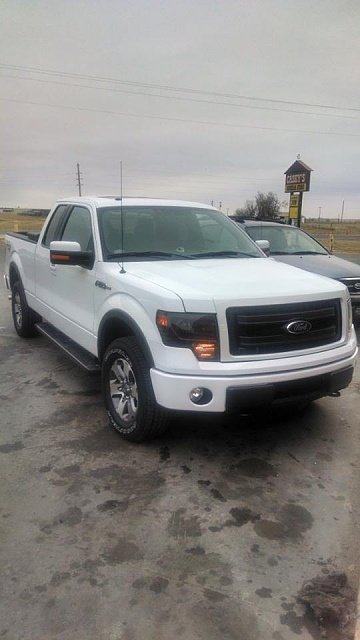
Take note the lack of leafy badges.

Couldn't be happier. Get out before you rack up as many miles as I did, Ford isn't going to fix this.
I only have my butt dyno to go buy, but this 5.0 feels more powerful than my Ecoboost after the multiple TSB nerfings. No turbo lag, V8 sound again, oh, and the projection headlights are awesome.
I'm getting the same highway mileage as my Ecoboost, 17ish, for whatever that's worth.
#2103
Senior Member
I honestly wouldn't take a service managers word. It's just like some of the salesmen at the dealerships I've been to that don't know squat about the vehicle they're trying to sell.
#2104
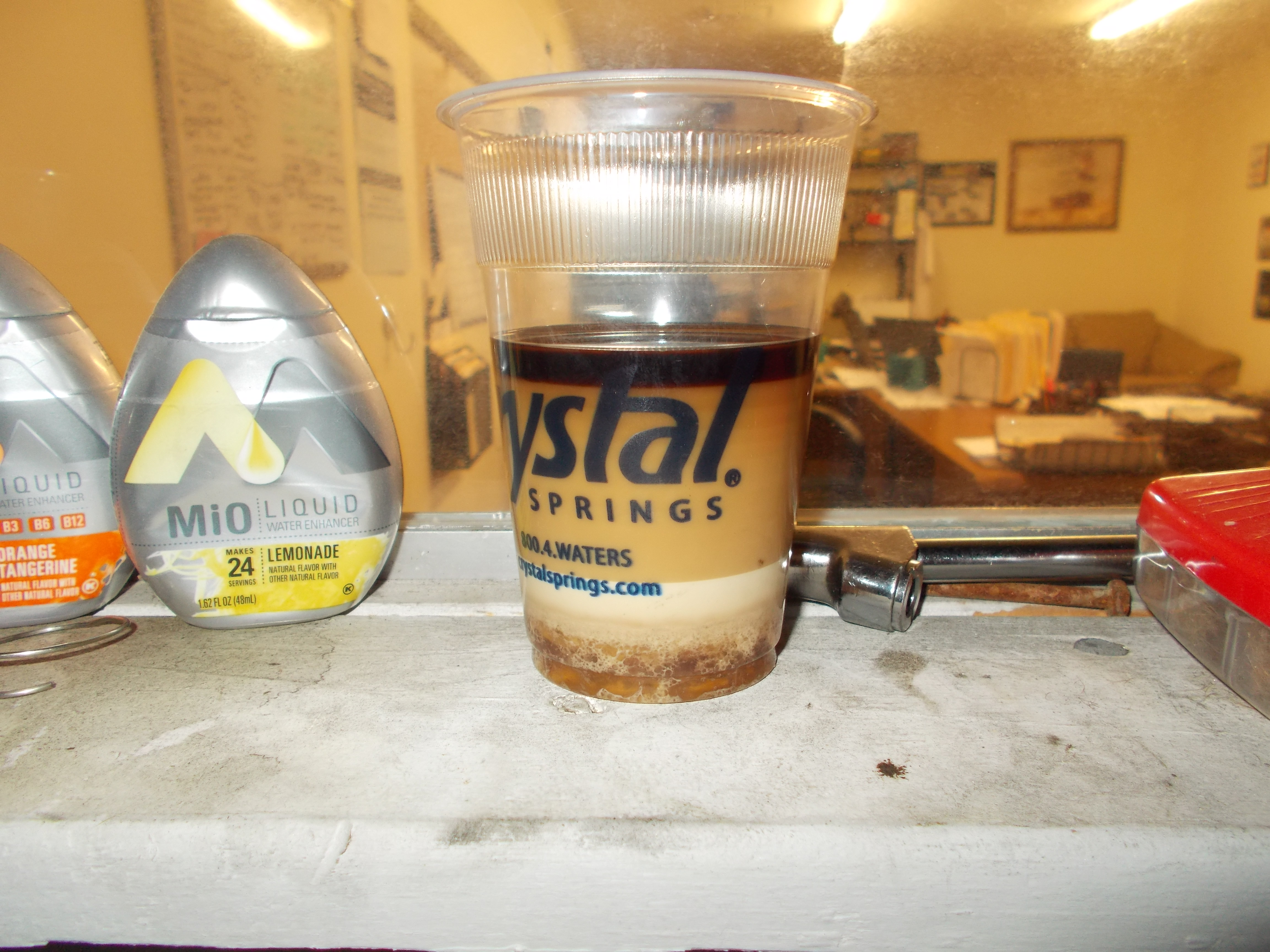
The small cans can, and will be filled to the outlet in no time flat and then all of the nasty mixture is pulling right past, but if pulled in at one tome as a gulp, hydro-lock occurs and since this cannot compress, rods bend and pistons break. You must have a system that takes all of this into account and most are just a bandaid that may work OK on a NA application, but will be very inadequate on a turbo application in weather below 45*F.
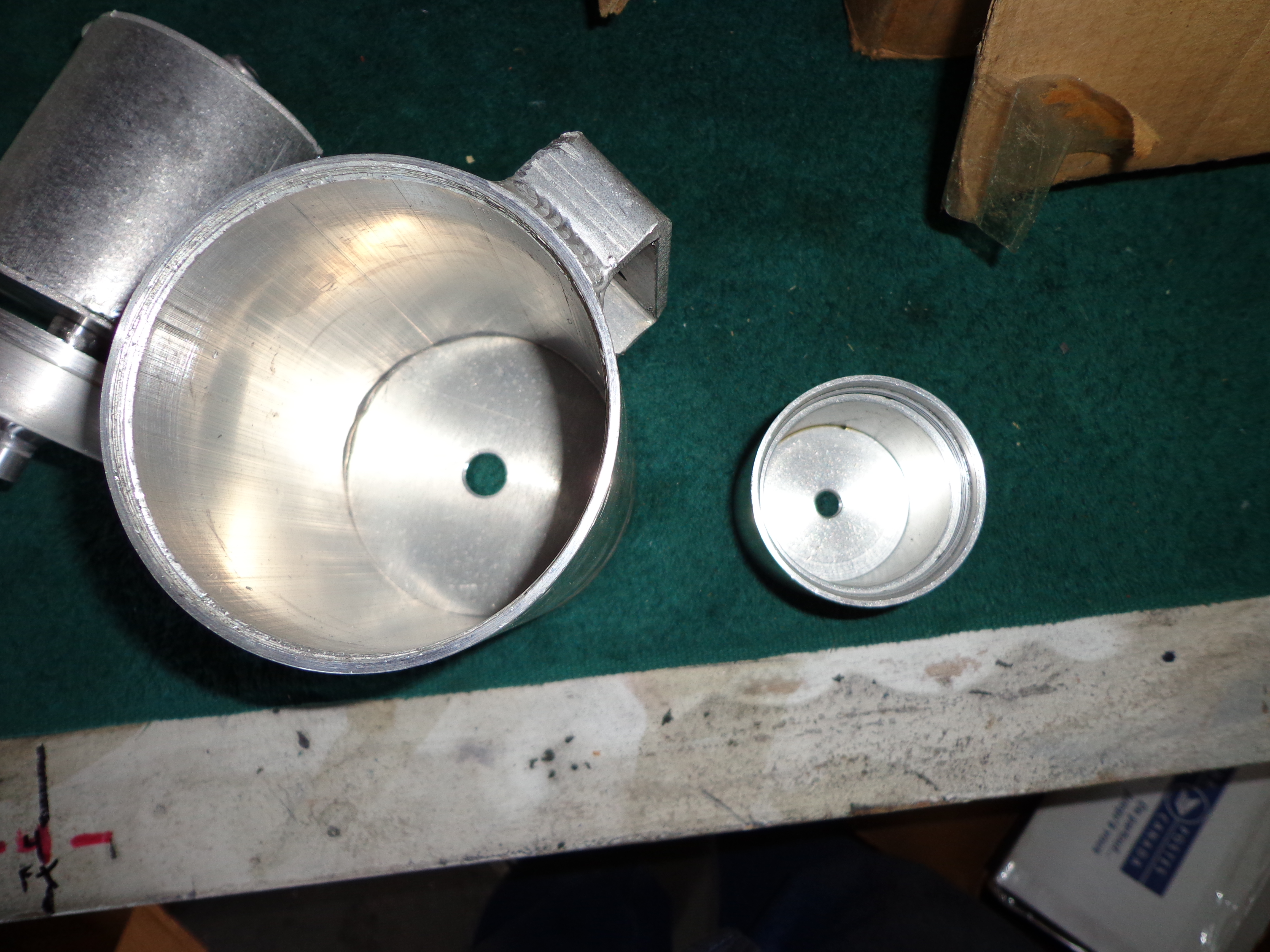
So if all this gunk is being removed with the PCV system in place, would you recommend a catch can be installed with the TT EB to remove such gunk? Ford did not add this feature so how much gunk can be collected in these pipes before it creates a performance issue w/the CAC system? And at what mileage interval would you recommend cleaning out the piping? Will FORD be adding a catch can system in the 2015 models?
What Ford, GM, Chrysler and all other are doing (Maserati and many supercars have had systems since the early 60's, but they are not the average $30-$50k consumer vehicle) is designing and implementing more effective crankcase dirty (foul) side baffle systems, but if made anymore effective than say 20% or so, they then catch the damaging compounds as well leaving them in the crankcase which drastically shortens life of the engine. So there will be no real solution for the consumer vehicles from the factory in the near future.
Only a proper aftermarket system, and to date only 1 does it correctly as most are put together by those that are pushing the sales over the engineering aspect, and this is one of the most misunderstood systems on todays cars and light trucks. It has been 2 generations since the actual function has been taught to automotive techs, tech today are taught to hook up diagnostic equipment and swap parts, read TSB's, and ask the support sources available to them...so very limited what they are taught or can access.
https://www.google.com/search?q=inta...h=816&dpr=0.95
New model releases are 3-4 years pretty much set in stone. Only minor changes are implemented, and since the average owner has no clue to these issues most dealers, and all the manufacturers have the official stance that "this is not a widespread issue". So easier to replace engines, intercoolers, etc. with the minority that do become educated or the growing owners that seek out forums suck as these to get an education and understand. The problem here and elsewhere is the mis-information and confusing "opinions" some post as fact. The internet makes anyone an "expert" so it gets confusing to sort through fact and fiction. Any that want a list of my qualifications and accomplishments, just ask. I won't post without request as it then encourages a thread to dissolve into drama and attacks.
In my experience, some of the least reliable information about future products comes from the very people that work for those companies. In fact, I've seen several people straight up "officially confirm" information that was clearly incorrect. I've been promised **** will by X by date so and so, then it shows up as Y and I'm irrevocably ****ed. And this is more than just automotive related stuff, industrial controls, power system equipment, etc, until it's in front of me or can be ordered, it's wild speculation.
Basically, I'll believe it when I see it.
Basically, I'll believe it when I see it.
And you cannot expect them to act any different. 99.9% of the purchasing public is influenced and controlled in so many ways. Think about the add on TV for a rewards credit card....at lunch fighting over who pays the tab. So they can accumulate reward points? Whats the return, spend $1000 to get $10 of points? Absolutely crazy from a common sense standpoint, yet the commercials work. They spend millions to air them. Very little today as far as decisions are mad on facts and analyzing. They are made from influence of the media (look at politics!!! My health plan went from $520 a month with no co-pay to $940 a month with huge co-pays......and I was promised it would reduce cost, and I could keep my plan??) Very little of what we decide now days is NOT influenced by an entity exerting influence and control over the general public. This is the way it is. Look at the emphasis on "2 years no-cost maintenance!", yet we see an inferior syn blend oil is used instead of the critical full synthetic these engine need to maintain the proper operation over time.
Now on to some more tech information.
Ford uses the intake manifold vacuum for evacuation while in non boost mode, but nothing during boost so all the toxic cocktail is pushed into the charge plumbing while in boost mode. So this is where this comes from.
GM uses the turbo inlet as suction/vacuum while in boost on the new ATS 2.oL turbo, but nothing during non-boost so the same occurs.
The proper system needs to use intake manifold vacuum while in boost, and turbo inlet while in-boost, with proper flowing checkvalves in place to prevent the boost from pressurizing the crankcase.
Here are pictures of the GM turbo (the hard steel tube from the turbo cold side hosing):
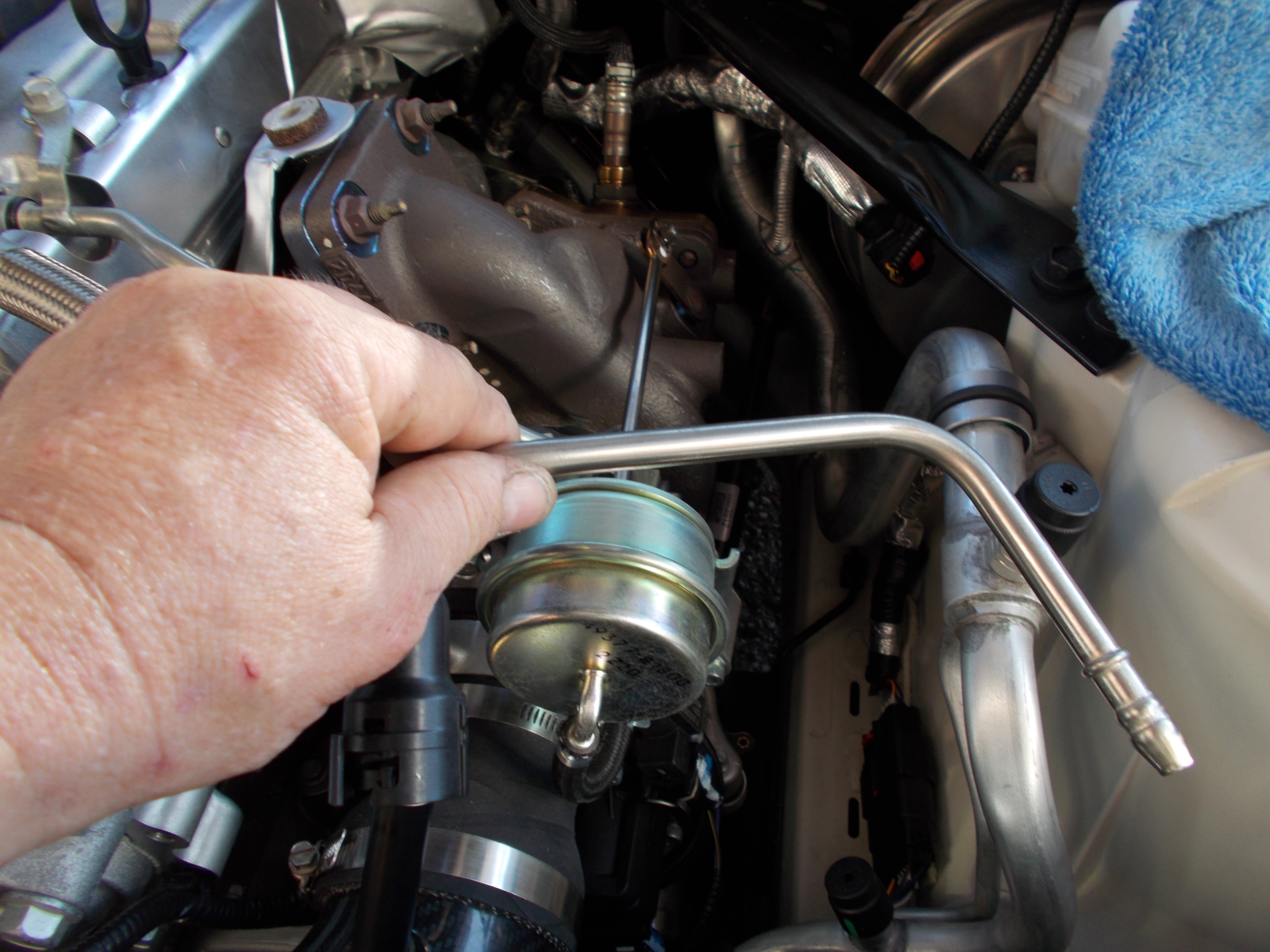
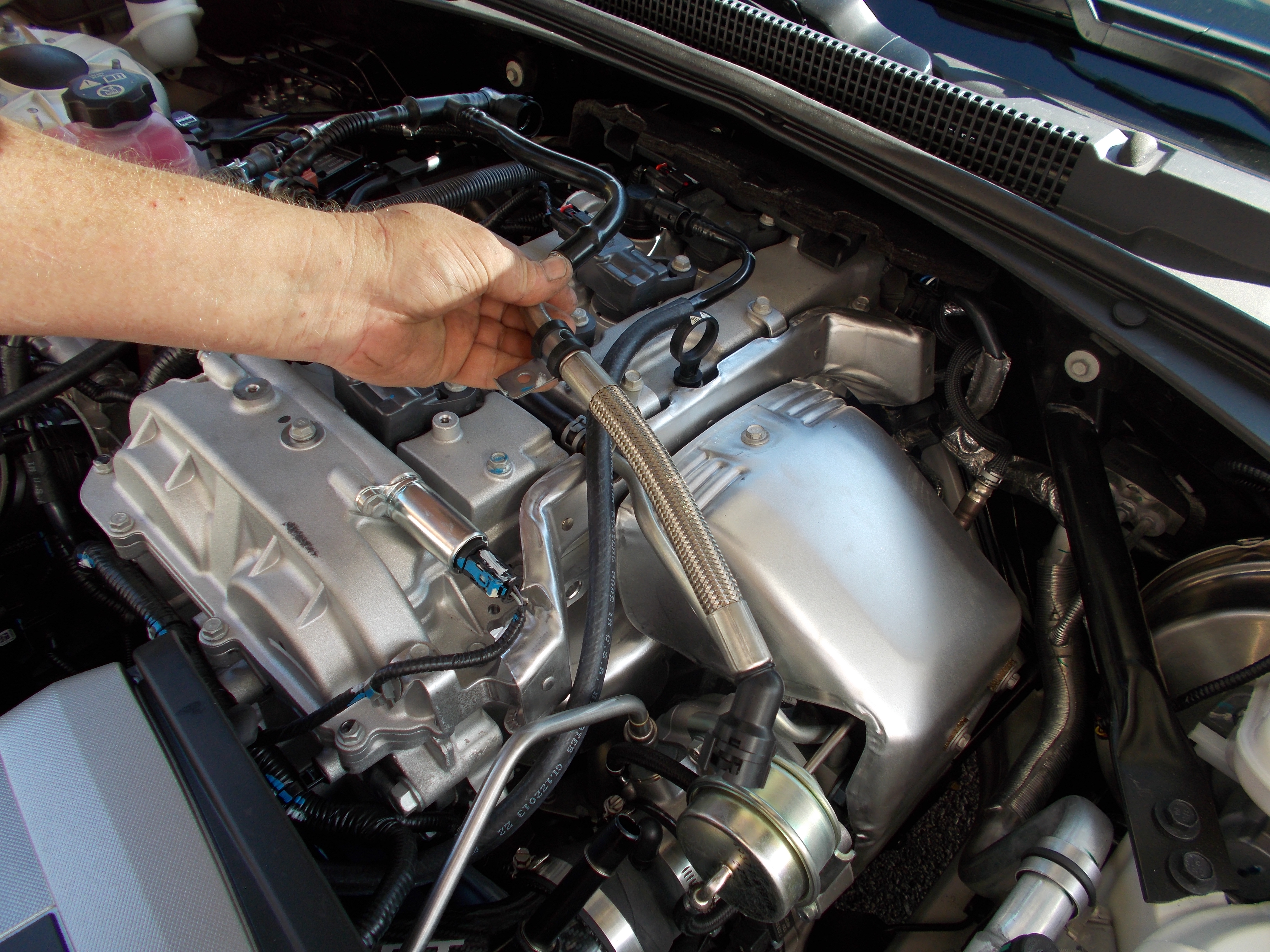
So to design a proper system, you need to utilize BOTH of what each uses, and then also address the stright through path the clean side uses as there will always be some point where the crankcase pressure exceeds the evacuation ability and back-flow (reversion) will result.
#2106
Exactly. And using one of the smaller catchcan units being sold for this can also result in just that, only quicker. Here is what you can expect to catch in a winter week with the RX system (several supporting vendors on here carry them, and it is the only system on the market that address each of these issues although others can be modified to work as well)
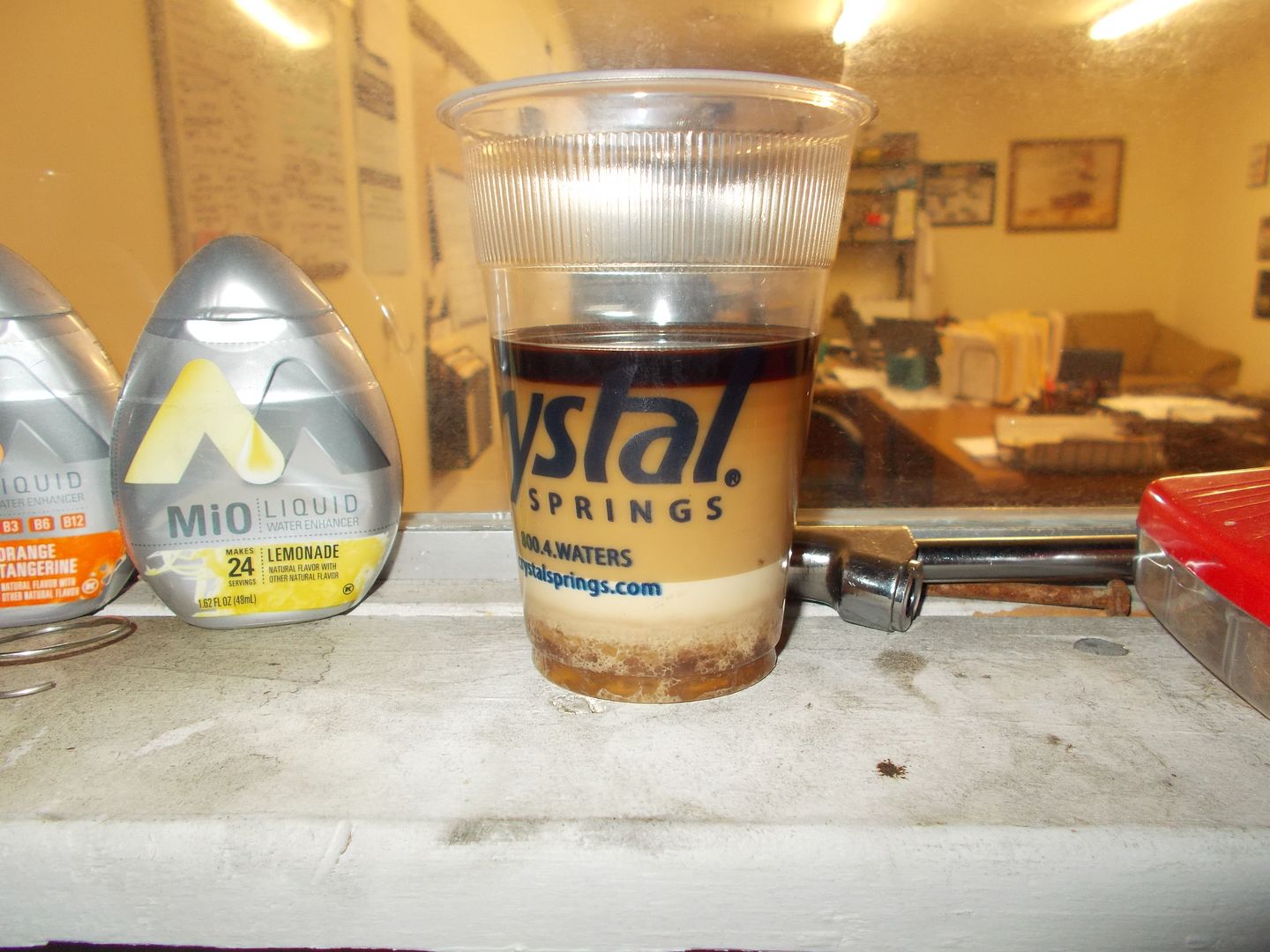
The small cans can, and will be filled to the outlet in no time flat and then all of the nasty mixture is pulling right past, but if pulled in at one tome as a gulp, hydro-lock occurs and since this cannot compress, rods bend and pistons break. You must have a system that takes all of this into account and most are just a bandaid that may work OK on a NA application, but will be very inadequate on a turbo application in weather below 45*F.
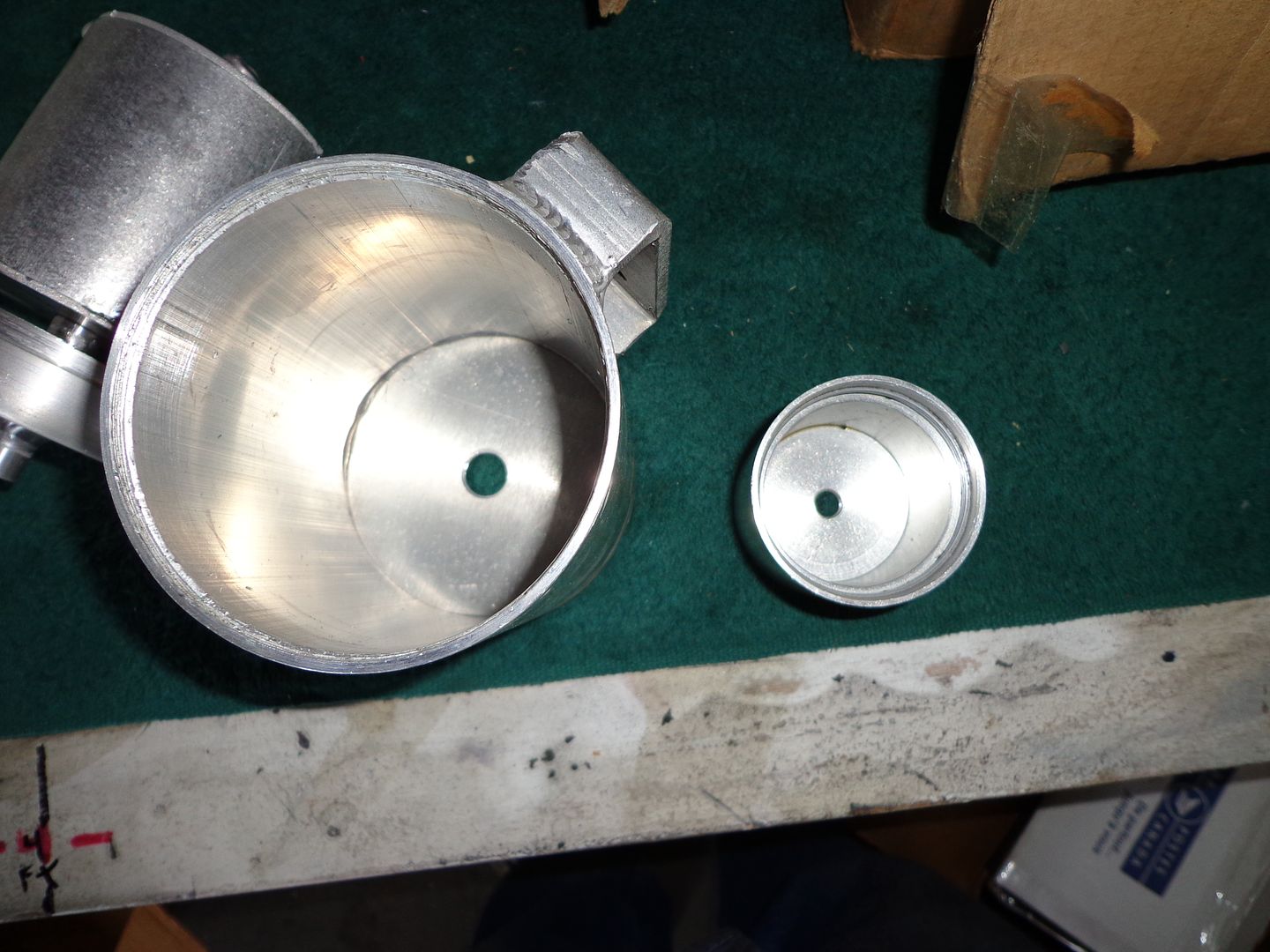
Ford, nor any other domestic or import manufacturer will be ever adding a true solution due to several things. One, the general purchasing public has been conditioned to expect less maintenance, and a proper system to cure this issue would bring into another process (draining these separators at strict intervals when the trend is buy the vehicle, put gas in, and drive for 10k plus miles before a DIC message prompts you to come in for service. And they cannot make a system that returns the oil to the crankcase (oil is a big part of the nasty cocktail causing these issues) as it would be adding a concentration of the damaging compounds the PCV system is designed to remove. There are solutions that purify and refine the oil from the rest of the compounds to return it to the crankcase safely, but they run from $8k to over $100k in cost and are usually only seen on industrial diesel , locomotives, freighters, etc. (Google search Alfa Laval to see them). These use a centrifuge type filtration system.
What Ford, GM, Chrysler and all other are doing (Maserati and many supercars have had systems since the early 60's, but they are not the average $30-$50k consumer vehicle) is designing and implementing more effective crankcase dirty (foul) side baffle systems, but if made anymore effective than say 20% or so, they then catch the damaging compounds as well leaving them in the crankcase which drastically shortens life of the engine. So there will be no real solution for the consumer vehicles from the factory in the near future.
Only a proper aftermarket system, and to date only 1 does it correctly as most are put together by those that are pushing the sales over the engineering aspect, and this is one of the most misunderstood systems on todays cars and light trucks. It has been 2 generations since the actual function has been taught to automotive techs, tech today are taught to hook up diagnostic equipment and swap parts, read TSB's, and ask the support sources available to them...so very limited what they are taught or can access.
Common. You had the rare experience of talking to 2 that told you straight and not spun with a corporate PR spin. Ford is not alone, this effects EVERY consumer mass produced car & light truck in the world, just to different degrees NA or boosted. If you do a Google search on "direct injection intake valve coking" you will find tech papers, SAE Docs, and discussions from techs from every auto manufacturer domestic or import. Play attention to Hyundai, Audi, VW, Nissan, BMW, etc. that implemented DI fuel delivery far earlier than the big 3.
https://www.google.com/search?q=inta...h=816&dpr=0.95
New model releases are 3-4 years pretty much set in stone. Only minor changes are implemented, and since the average owner has no clue to these issues most dealers, and all the manufacturers have the official stance that "this is not a widespread issue". So easier to replace engines, intercoolers, etc. with the minority that do become educated or the growing owners that seek out forums suck as these to get an education and understand. The problem here and elsewhere is the mis-information and confusing "opinions" some post as fact. The internet makes anyone an "expert" so it gets confusing to sort through fact and fiction. Any that want a list of my qualifications and accomplishments, just ask. I won't post without request as it then encourages a thread to dissolve into drama and attacks.
You are one of the few w/out blinders on their eyes and mind. Face it, there is not a single manufacturer that does not filter ALL that is disseminated to the public through the PR channels, and all engineers are tightly bound by non disclosure agreements. I worked for them before (40 years ago) all of the legal and political BS had reached such extremes, but it has ALWAYS been part of the marketing, etc. of the auto makers and any large corp.
And you cannot expect them to act any different. 99.9% of the purchasing public is influenced and controlled in so many ways. Think about the add on TV for a rewards credit card....at lunch fighting over who pays the tab. So they can accumulate reward points? Whats the return, spend $1000 to get $10 of points? Absolutely crazy from a common sense standpoint, yet the commercials work. They spend millions to air them. Very little today as far as decisions are mad on facts and analyzing. They are made from influence of the media (look at politics!!! My health plan went from $520 a month with no co-pay to $940 a month with huge co-pays......and I was promised it would reduce cost, and I could keep my plan??) Very little of what we decide now days is NOT influenced by an entity exerting influence and control over the general public. This is the way it is. Look at the emphasis on "2 years no-cost maintenance!", yet we see an inferior syn blend oil is used instead of the critical full synthetic these engine need to maintain the proper operation over time.
True in 99% of the cases, but there still are some honest, and informed service managers and senior techs, just fewer as time goes by...and 99.9% of salesman will say any BS for the sale. Look at the rate of attrition...most don't last 6 months at any one dealership.
Now on to some more tech information.
Ford uses the intake manifold vacuum for evacuation while in non boost mode, but nothing during boost so all the toxic cocktail is pushed into the charge plumbing while in boost mode. So this is where this comes from.
GM uses the turbo inlet as suction/vacuum while in boost on the new ATS 2.oL turbo, but nothing during non-boost so the same occurs.
The proper system needs to use intake manifold vacuum while in boost, and turbo inlet while in-boost, with proper flowing checkvalves in place to prevent the boost from pressurizing the crankcase.
Here are pictures of the GM turbo (the hard steel tube from the turbo cold side hosing):
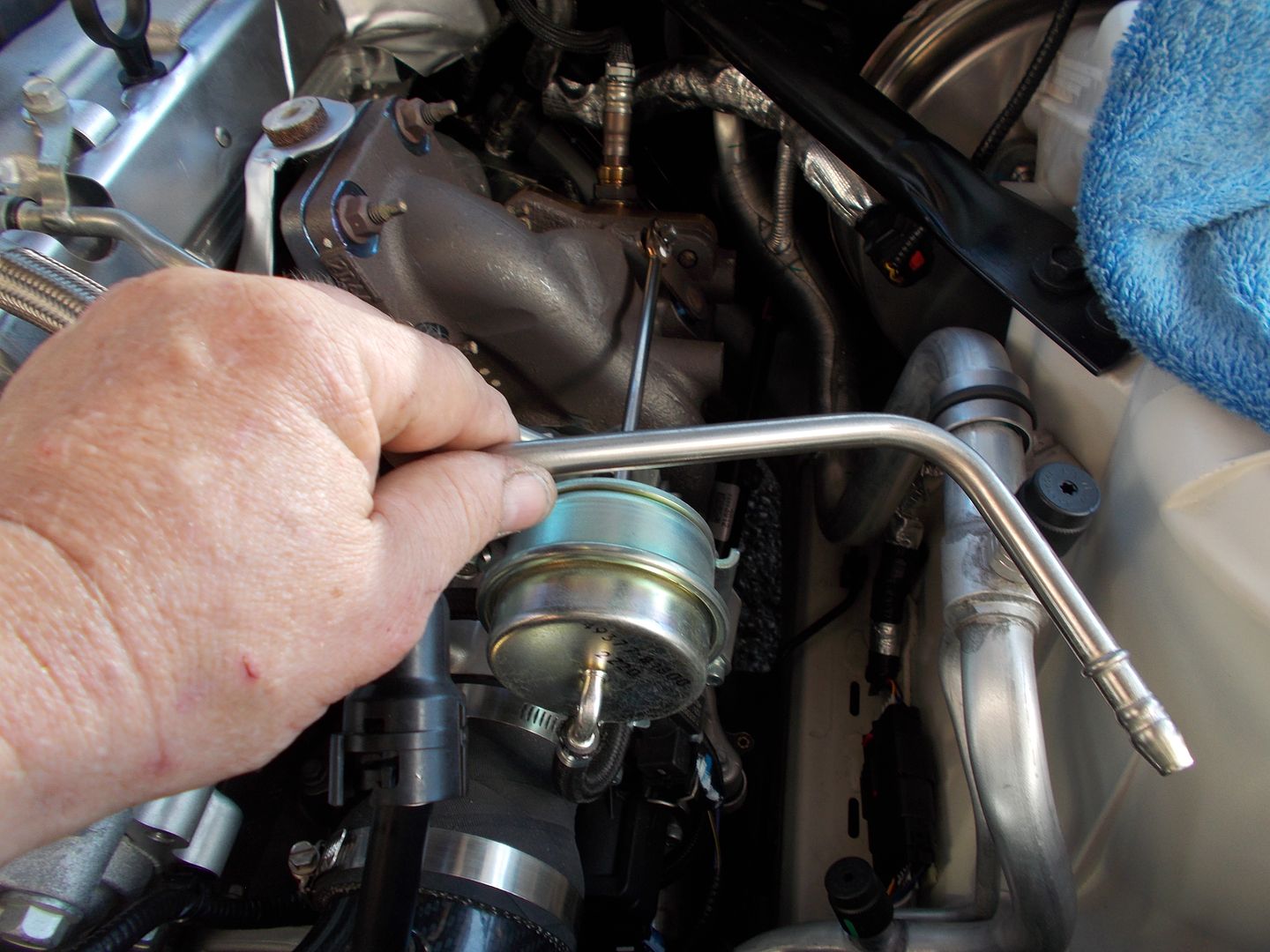
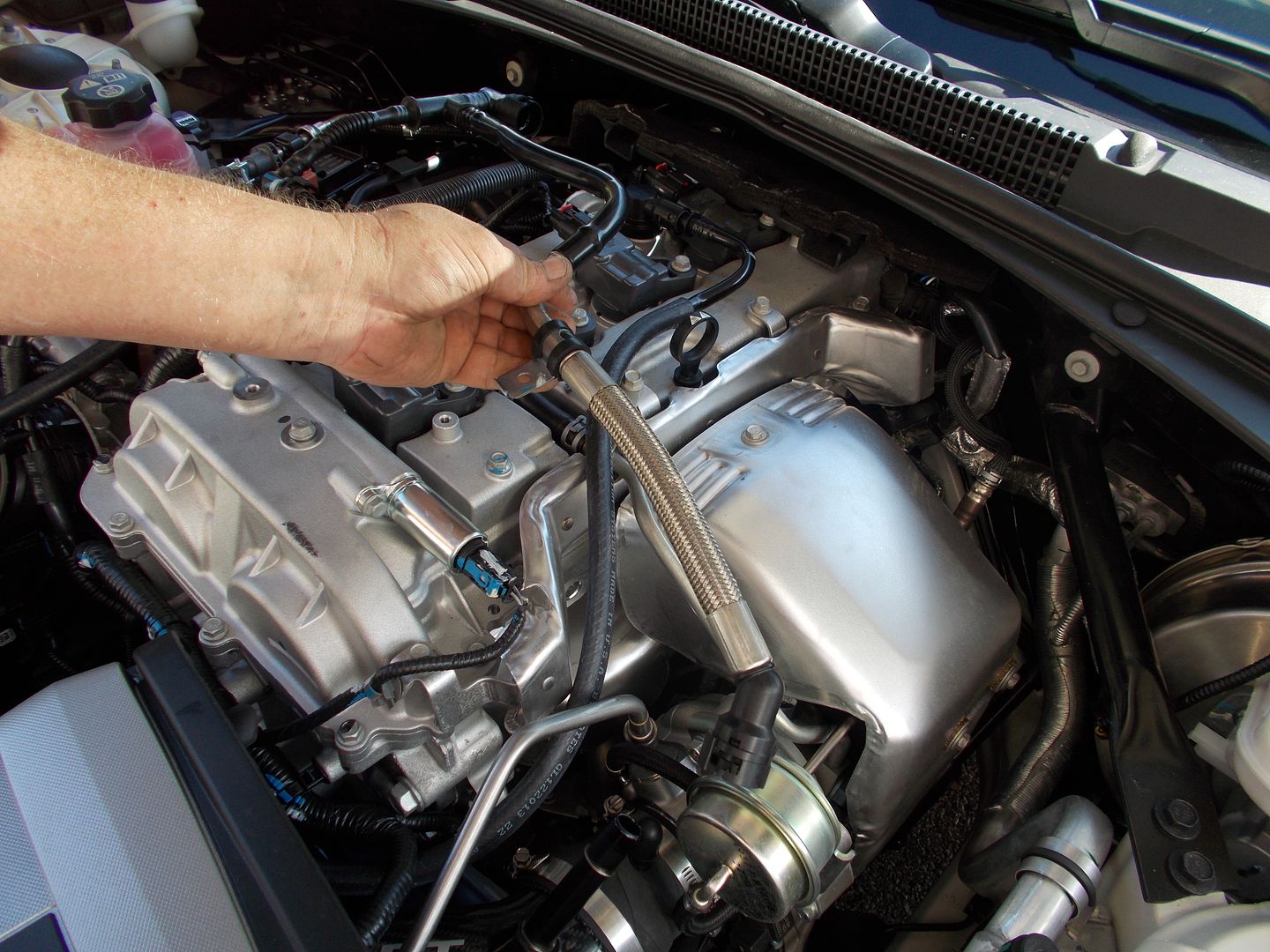
So to design a proper system, you need to utilize BOTH of what each uses, and then also address the stright through path the clean side uses as there will always be some point where the crankcase pressure exceeds the evacuation ability and back-flow (reversion) will result.

The small cans can, and will be filled to the outlet in no time flat and then all of the nasty mixture is pulling right past, but if pulled in at one tome as a gulp, hydro-lock occurs and since this cannot compress, rods bend and pistons break. You must have a system that takes all of this into account and most are just a bandaid that may work OK on a NA application, but will be very inadequate on a turbo application in weather below 45*F.

Ford, nor any other domestic or import manufacturer will be ever adding a true solution due to several things. One, the general purchasing public has been conditioned to expect less maintenance, and a proper system to cure this issue would bring into another process (draining these separators at strict intervals when the trend is buy the vehicle, put gas in, and drive for 10k plus miles before a DIC message prompts you to come in for service. And they cannot make a system that returns the oil to the crankcase (oil is a big part of the nasty cocktail causing these issues) as it would be adding a concentration of the damaging compounds the PCV system is designed to remove. There are solutions that purify and refine the oil from the rest of the compounds to return it to the crankcase safely, but they run from $8k to over $100k in cost and are usually only seen on industrial diesel , locomotives, freighters, etc. (Google search Alfa Laval to see them). These use a centrifuge type filtration system.
What Ford, GM, Chrysler and all other are doing (Maserati and many supercars have had systems since the early 60's, but they are not the average $30-$50k consumer vehicle) is designing and implementing more effective crankcase dirty (foul) side baffle systems, but if made anymore effective than say 20% or so, they then catch the damaging compounds as well leaving them in the crankcase which drastically shortens life of the engine. So there will be no real solution for the consumer vehicles from the factory in the near future.
Only a proper aftermarket system, and to date only 1 does it correctly as most are put together by those that are pushing the sales over the engineering aspect, and this is one of the most misunderstood systems on todays cars and light trucks. It has been 2 generations since the actual function has been taught to automotive techs, tech today are taught to hook up diagnostic equipment and swap parts, read TSB's, and ask the support sources available to them...so very limited what they are taught or can access.
Common. You had the rare experience of talking to 2 that told you straight and not spun with a corporate PR spin. Ford is not alone, this effects EVERY consumer mass produced car & light truck in the world, just to different degrees NA or boosted. If you do a Google search on "direct injection intake valve coking" you will find tech papers, SAE Docs, and discussions from techs from every auto manufacturer domestic or import. Play attention to Hyundai, Audi, VW, Nissan, BMW, etc. that implemented DI fuel delivery far earlier than the big 3.
https://www.google.com/search?q=inta...h=816&dpr=0.95
New model releases are 3-4 years pretty much set in stone. Only minor changes are implemented, and since the average owner has no clue to these issues most dealers, and all the manufacturers have the official stance that "this is not a widespread issue". So easier to replace engines, intercoolers, etc. with the minority that do become educated or the growing owners that seek out forums suck as these to get an education and understand. The problem here and elsewhere is the mis-information and confusing "opinions" some post as fact. The internet makes anyone an "expert" so it gets confusing to sort through fact and fiction. Any that want a list of my qualifications and accomplishments, just ask. I won't post without request as it then encourages a thread to dissolve into drama and attacks.
You are one of the few w/out blinders on their eyes and mind. Face it, there is not a single manufacturer that does not filter ALL that is disseminated to the public through the PR channels, and all engineers are tightly bound by non disclosure agreements. I worked for them before (40 years ago) all of the legal and political BS had reached such extremes, but it has ALWAYS been part of the marketing, etc. of the auto makers and any large corp.
And you cannot expect them to act any different. 99.9% of the purchasing public is influenced and controlled in so many ways. Think about the add on TV for a rewards credit card....at lunch fighting over who pays the tab. So they can accumulate reward points? Whats the return, spend $1000 to get $10 of points? Absolutely crazy from a common sense standpoint, yet the commercials work. They spend millions to air them. Very little today as far as decisions are mad on facts and analyzing. They are made from influence of the media (look at politics!!! My health plan went from $520 a month with no co-pay to $940 a month with huge co-pays......and I was promised it would reduce cost, and I could keep my plan??) Very little of what we decide now days is NOT influenced by an entity exerting influence and control over the general public. This is the way it is. Look at the emphasis on "2 years no-cost maintenance!", yet we see an inferior syn blend oil is used instead of the critical full synthetic these engine need to maintain the proper operation over time.
True in 99% of the cases, but there still are some honest, and informed service managers and senior techs, just fewer as time goes by...and 99.9% of salesman will say any BS for the sale. Look at the rate of attrition...most don't last 6 months at any one dealership.
Now on to some more tech information.
Ford uses the intake manifold vacuum for evacuation while in non boost mode, but nothing during boost so all the toxic cocktail is pushed into the charge plumbing while in boost mode. So this is where this comes from.
GM uses the turbo inlet as suction/vacuum while in boost on the new ATS 2.oL turbo, but nothing during non-boost so the same occurs.
The proper system needs to use intake manifold vacuum while in boost, and turbo inlet while in-boost, with proper flowing checkvalves in place to prevent the boost from pressurizing the crankcase.
Here are pictures of the GM turbo (the hard steel tube from the turbo cold side hosing):


So to design a proper system, you need to utilize BOTH of what each uses, and then also address the stright through path the clean side uses as there will always be some point where the crankcase pressure exceeds the evacuation ability and back-flow (reversion) will result.
Wow, so if I understood you correctly, you are better off not putting any catch can on your truck due to the fact it fills up quickly and if not drained timely the rest of the gunk will be fed into your crankcase because you circumvented the PCV system designed to pull that crap out and deposit into your IC piping..So it seems it is better to leave things alone and just take apart piping and pull/flush all that crap out from time to time to keep it as clean as you can and avoid heavy acclerations. 45 degrees is not that cold in most areas and for it to sludge up like that in huge chunks cannot be good for your engine. Based on what you've explained..What would be the best way to extend the life of your EB engine and avoid the issues this Kahlua and cream cocktail can create.?
#2107
We first take the dirty (foul) side line off of the intake manifold upper front passnegr side of the IM and the cam cover on the passenger side. This is where a good amount of the ingestion takes place. You can slit the hard plastic from the fittings to reuse the fittings with other lines:
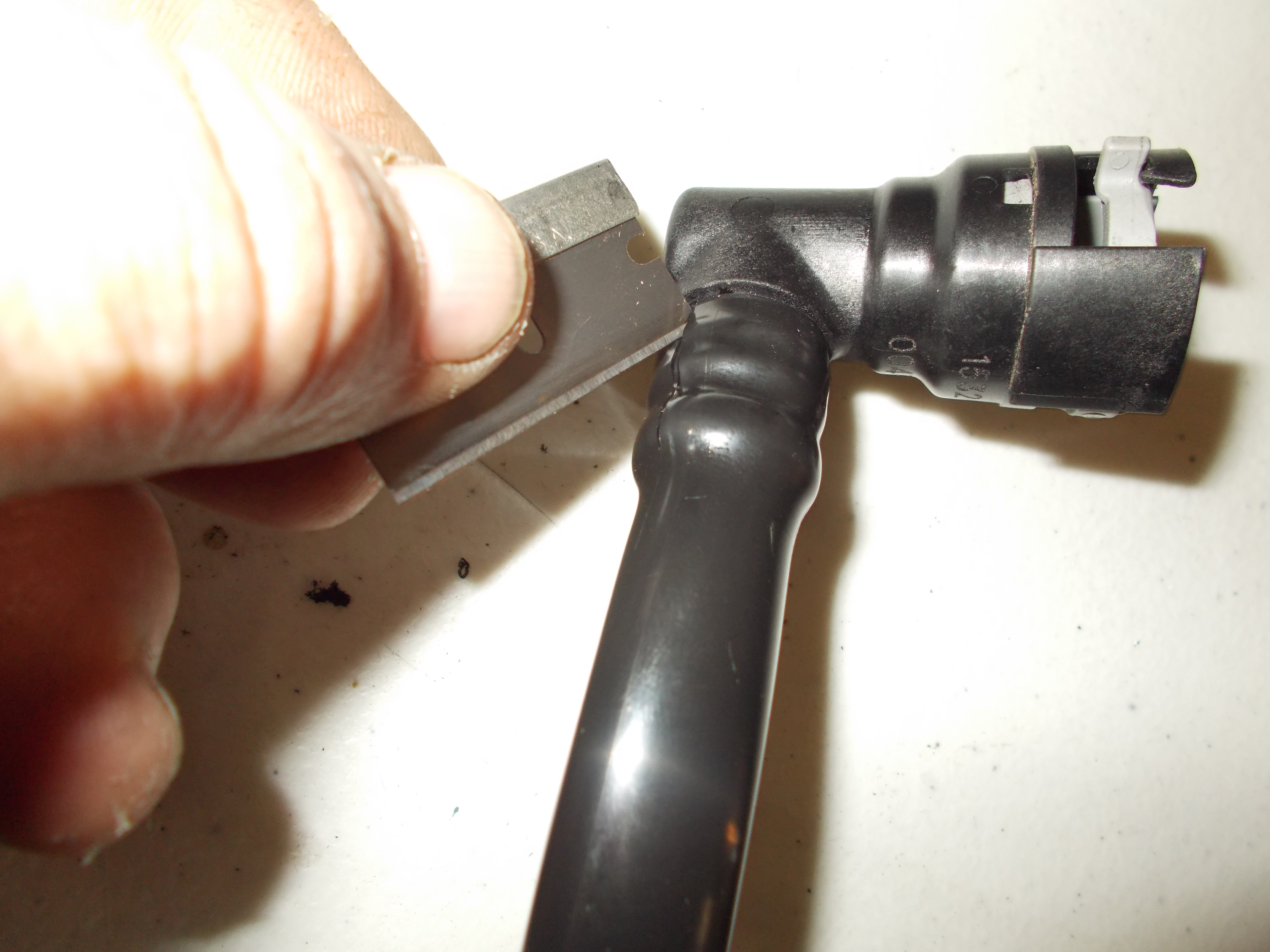
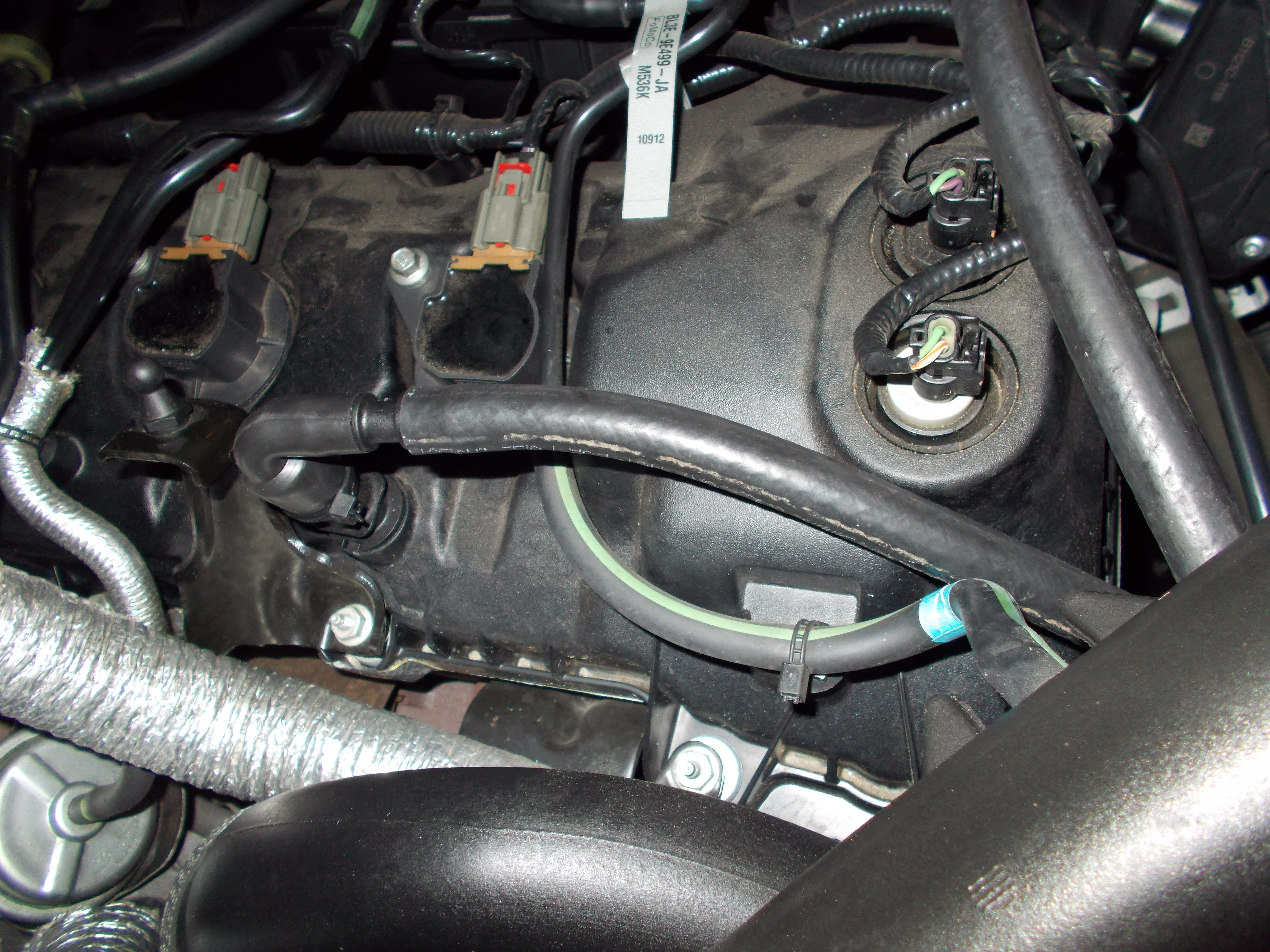
The cam cover side is going to run (in this case the RX separator) to the center inlet of the oil/water separator:
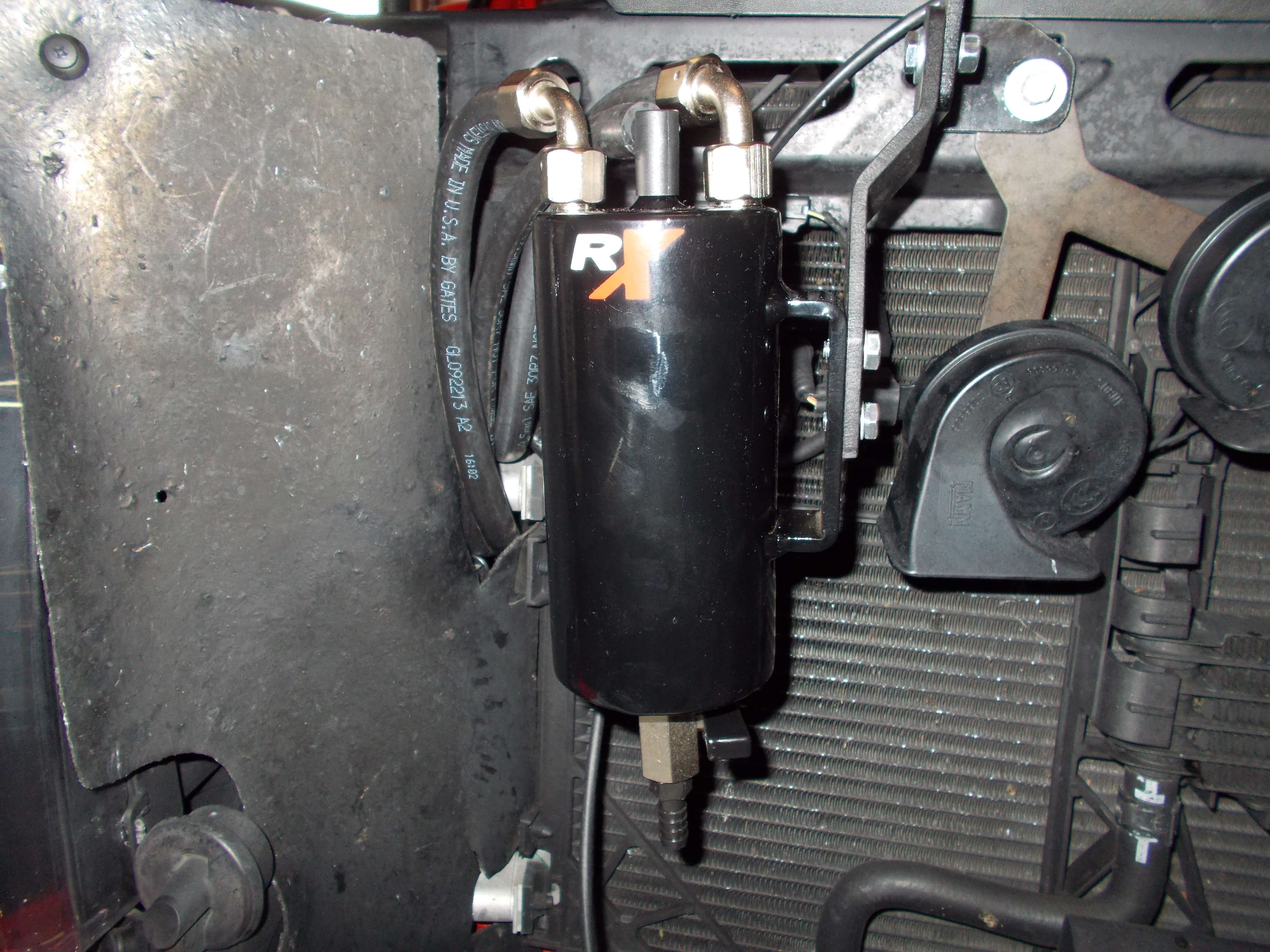
The intake manifold side is then going to run from the primary outlet on the can (one of the outer fittings) to the IM and a oneway checkvalve is installed in this line to prevent any boost pressure from backflowing while in boost.

This now addresses stopping the oil/water gunk from entering the intake manifold directly as it had before, in non-boost operation. Now we need to address what happens when in-boost operation, and that requires tapping into the inlet, or suction side of the turbos.
We do this by drilling in as close to the turbo inlets as possible to reach (the further from the turbo inlet, the less suction is realized so go close):
Passenger side:
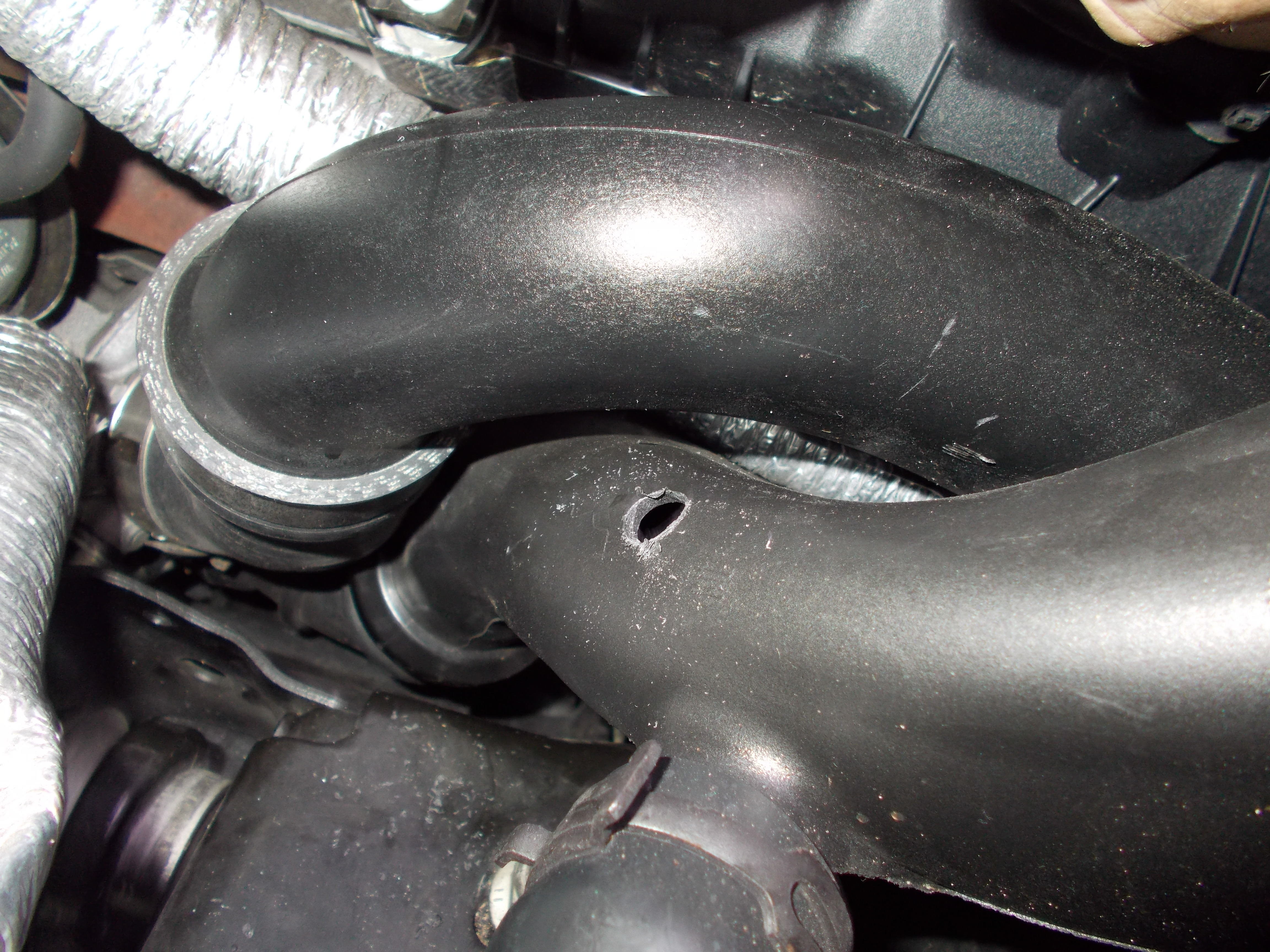
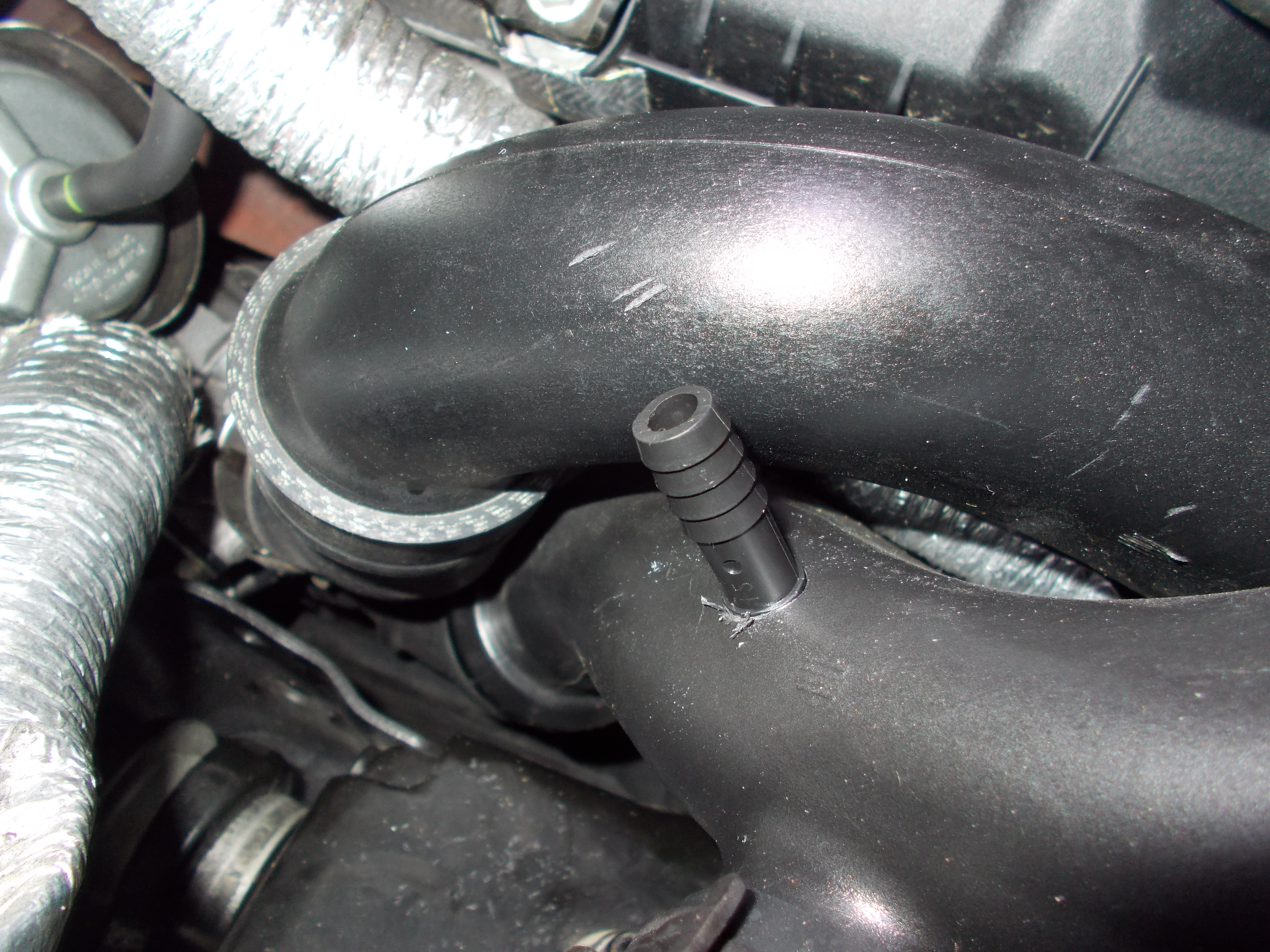


The cam cover side is going to run (in this case the RX separator) to the center inlet of the oil/water separator:

The intake manifold side is then going to run from the primary outlet on the can (one of the outer fittings) to the IM and a oneway checkvalve is installed in this line to prevent any boost pressure from backflowing while in boost.

This now addresses stopping the oil/water gunk from entering the intake manifold directly as it had before, in non-boost operation. Now we need to address what happens when in-boost operation, and that requires tapping into the inlet, or suction side of the turbos.
We do this by drilling in as close to the turbo inlets as possible to reach (the further from the turbo inlet, the less suction is realized so go close):
Passenger side:


#2108
This will then be "T"d to a barb added to the same location on the drivers side, utilizing suction from both turbos:
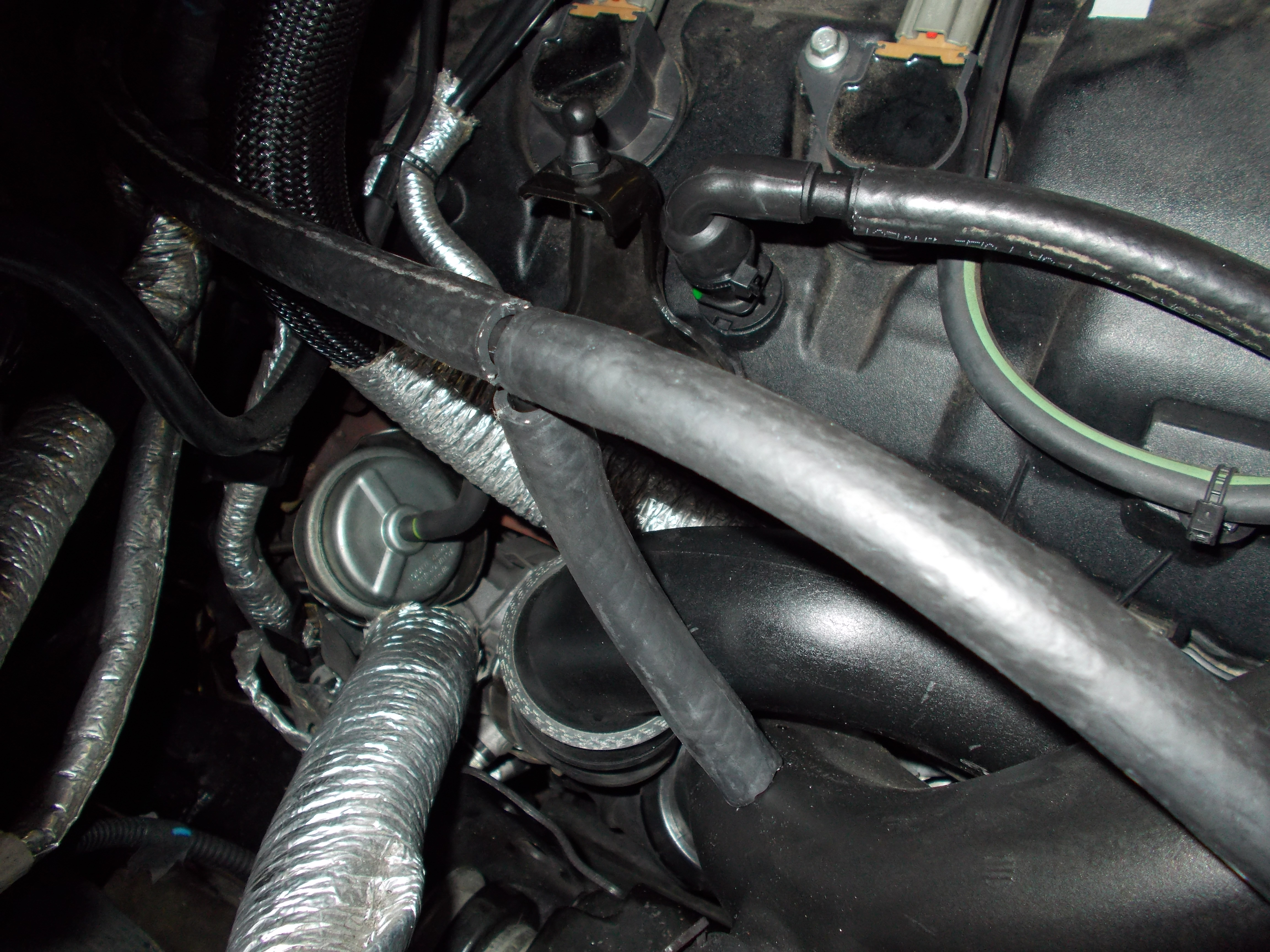
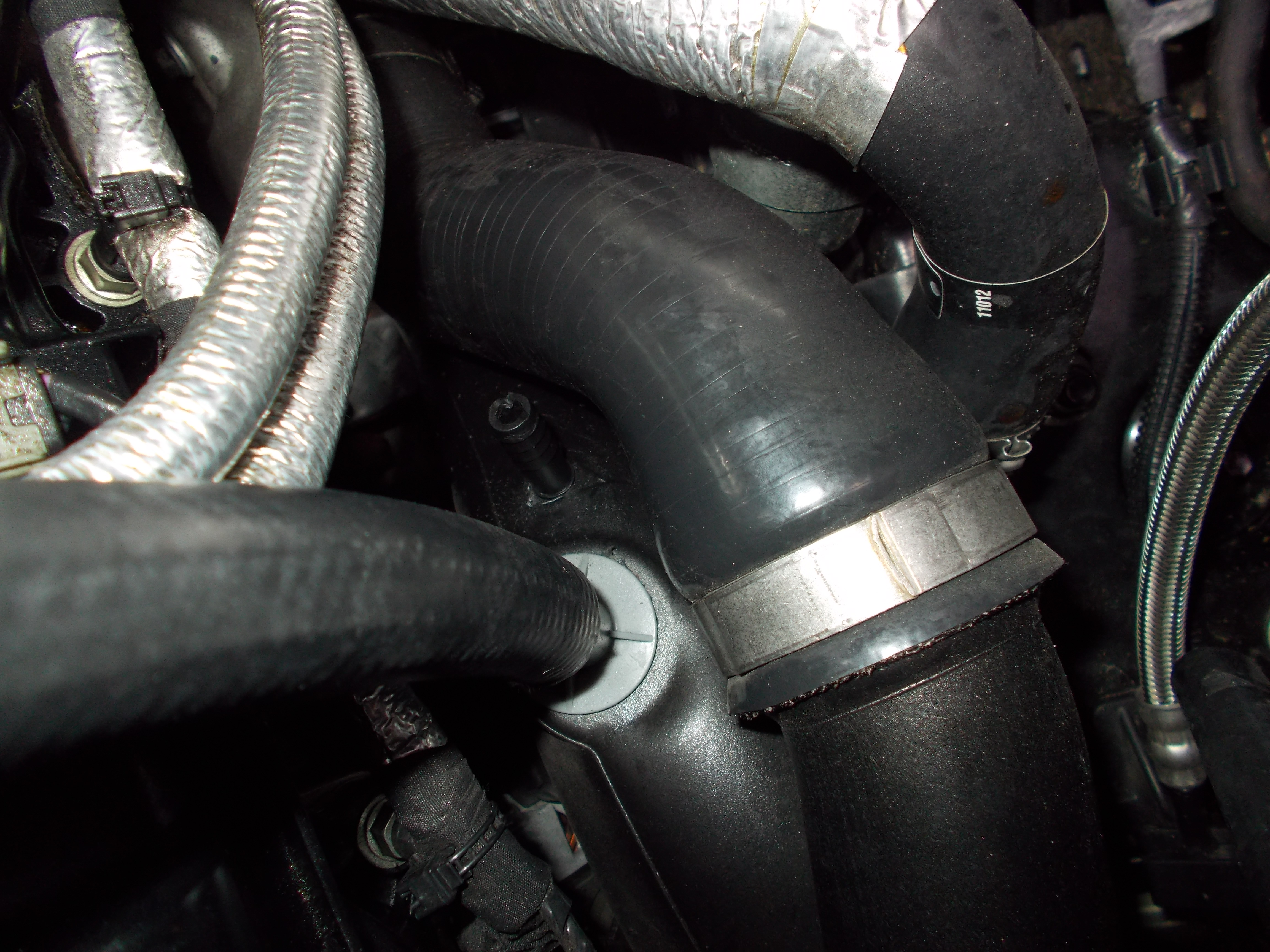
This has now used the suction sources of both Ford and GM together, so while in non boost mode, you are using the intake manifold to evacuate the compounds, run them through a properly sized and designed separating can, and stopping the ingestion. And when the engine transitions into boost mode, where the IM is pressurized, the primary checkvalve using the IM for evac senses this and closes. The secondary valve, using the turbo inlets as evacuation them opens, so the system is now providing constant evacuation no matter what mode it is in, and the damaging cocktail of oil/water/sufuric acid, etc. has been filtered out and trapped (and this needs to be drained...every 1000 miles or so in the winter, and every oil change in the summer as any temps below 45*F will result in a ton of condensation forming in the crankcase and this MUST be removed before it can condense upon shut down when the engine cools allowing it to accumulate in the crankcase).
Now we have one final point of ingestion, and this is the clean, or fresh side of the PCV system. This is a line that goes straight from the drivers side cam cover (on a non OHC engine called the valve cover) to a grey barb on the drivers side intake tube, a few inches above where we drilled into it to utilize the suction from the drivers side turbo. This still would allow the vapors to backflow momentarily into the intake charge even with the dual evacuation suction sources, where before as stock it allowed ALL of it to flow in when in boost mode. We now will reove that line, cap the cam cover, and replace the oil fill cap with a cleanside separator that channels all of this through. Since it is only momentary when it would backflow (unlike before) we do not want to trap and collect this, as it is mainly the oil we want to trap and can return to the crankcase as there will little time for anything harmful to be caught as well. So 99.9% of the time the filtered fresh make up air for the the crankcase evacuation is traveling into the engine crankcase:
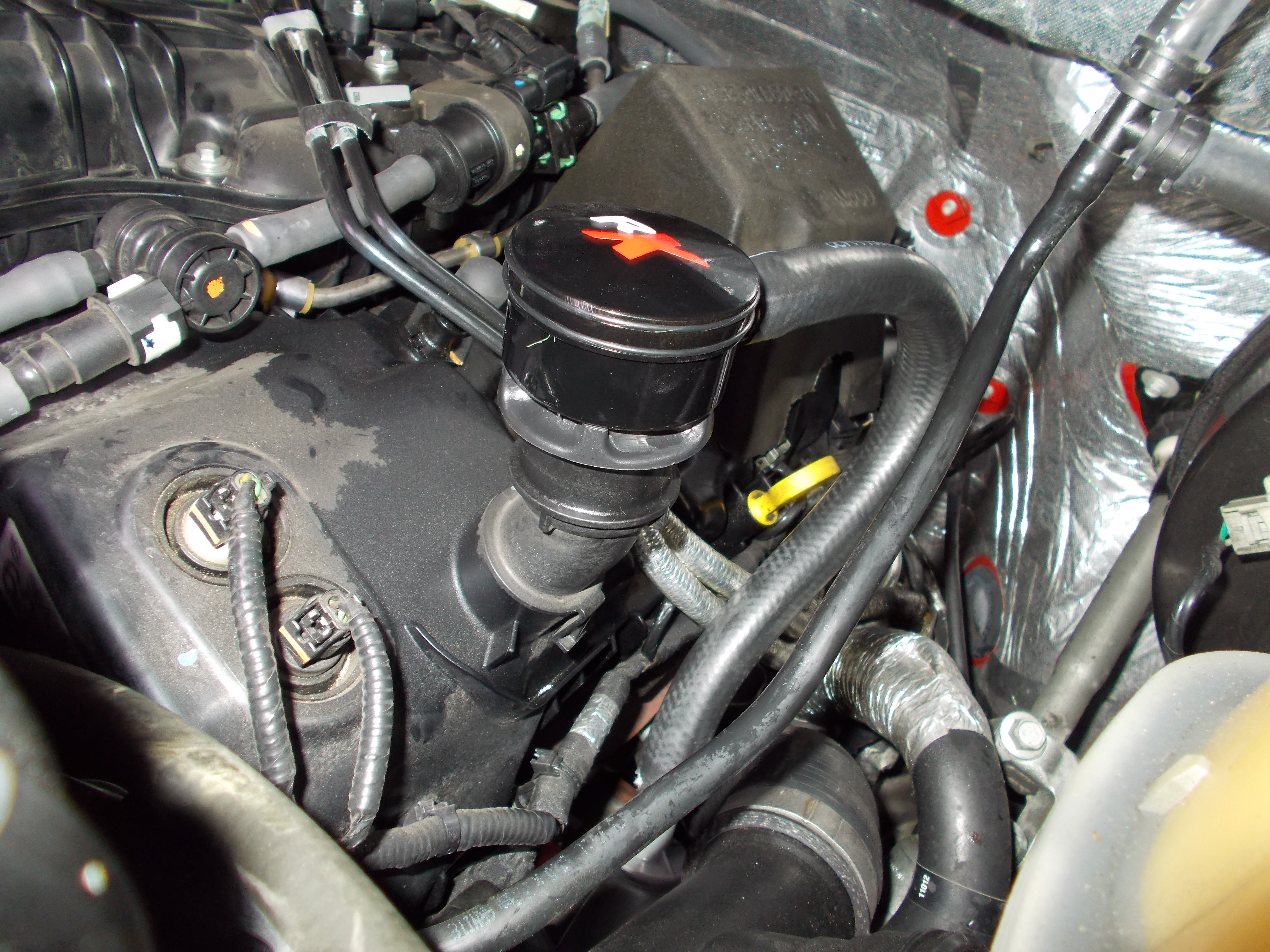
In the picture above, you can see the cam cover barb is now capped, and all of the fresh side air enters through the cleanside separator into the crankcase. Both the raised path (using gravity as the stock barb is straight into the intake tube) and the coalescing material in the separation chamber prevent oil from entering via this point:
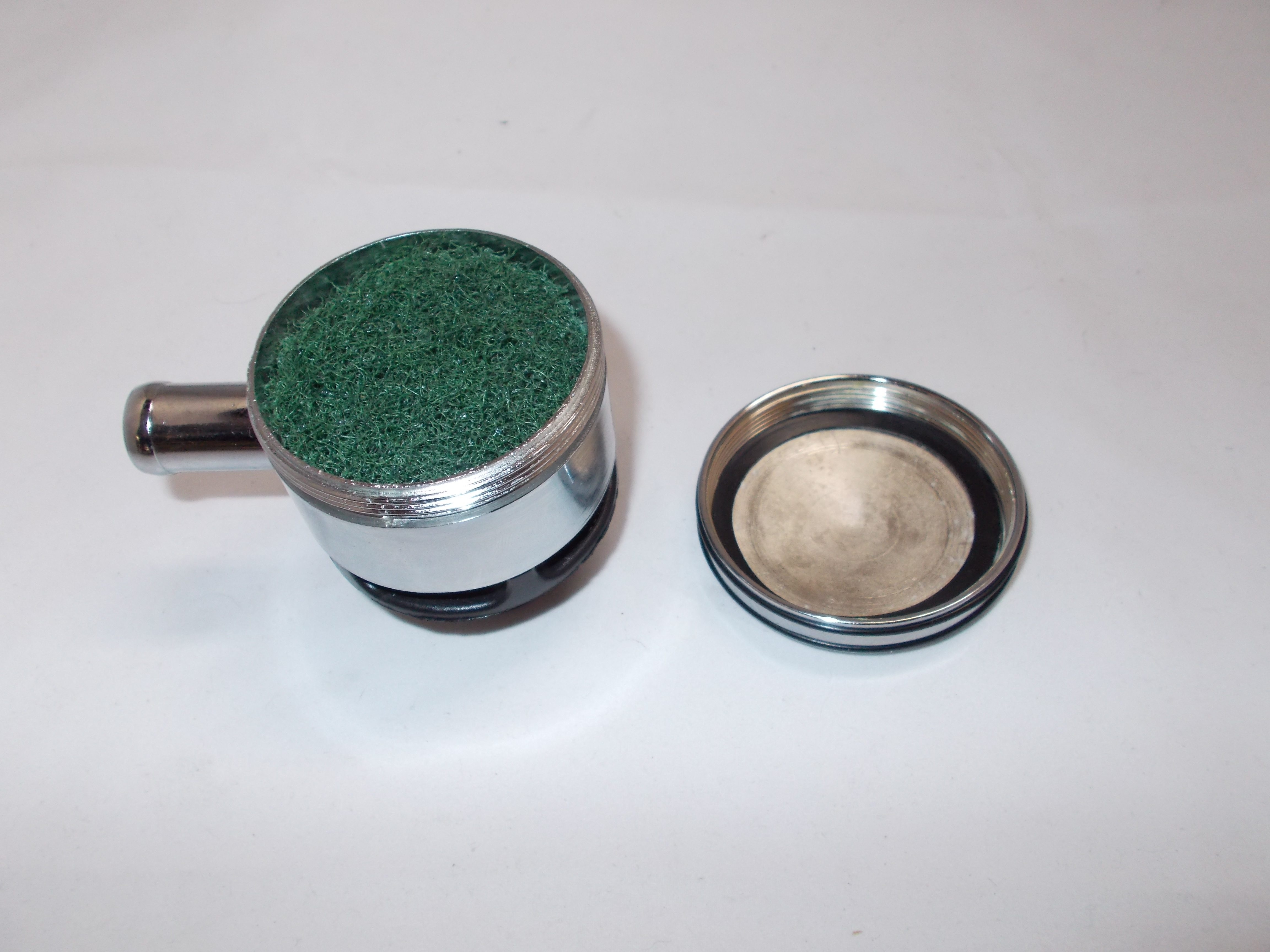
So a true, complete solution that provides constant evacuation during all modes of operation, and truly traps and separates all, or nearly all the suspend damaging compounds, with the capacity to contain the large amount that is present in cold months, and eliminates the solid gunk build up in the intercooler and charge pipes, plus eliminates the intake valve coking deposits (remember, and small ineffective can no matter what brand name, or how nice it looks, still lets a good deal of all this to pass right through and does NOT eliminate the issue, only makes the user feel good as they see it catches some) from robbing power and fuel economy.
Another advantage is since you have removed the oil from entering the combustion chamber, you now have eliminated a source of detonation that before caused the PCM/ECU to pull timing, resulting now in the engine running at optimum ignition timing and an increase in fuel economy on average of 103 MPG.
The residue left from the oil burning in the combustion chamber is now not present to build up on the ringlands causing them to stick and not move freely, which compounds oil consumption, etc.
Now lets get more tech questions on each step of this, the processes that take place, and anything else anyone can think of....and again, for those that are happy with the way it comes from the factory (those that believe each vehicle is the best it could possibly be when sold from the dealer), please disregard all of this. as you have no issues.



This has now used the suction sources of both Ford and GM together, so while in non boost mode, you are using the intake manifold to evacuate the compounds, run them through a properly sized and designed separating can, and stopping the ingestion. And when the engine transitions into boost mode, where the IM is pressurized, the primary checkvalve using the IM for evac senses this and closes. The secondary valve, using the turbo inlets as evacuation them opens, so the system is now providing constant evacuation no matter what mode it is in, and the damaging cocktail of oil/water/sufuric acid, etc. has been filtered out and trapped (and this needs to be drained...every 1000 miles or so in the winter, and every oil change in the summer as any temps below 45*F will result in a ton of condensation forming in the crankcase and this MUST be removed before it can condense upon shut down when the engine cools allowing it to accumulate in the crankcase).
Now we have one final point of ingestion, and this is the clean, or fresh side of the PCV system. This is a line that goes straight from the drivers side cam cover (on a non OHC engine called the valve cover) to a grey barb on the drivers side intake tube, a few inches above where we drilled into it to utilize the suction from the drivers side turbo. This still would allow the vapors to backflow momentarily into the intake charge even with the dual evacuation suction sources, where before as stock it allowed ALL of it to flow in when in boost mode. We now will reove that line, cap the cam cover, and replace the oil fill cap with a cleanside separator that channels all of this through. Since it is only momentary when it would backflow (unlike before) we do not want to trap and collect this, as it is mainly the oil we want to trap and can return to the crankcase as there will little time for anything harmful to be caught as well. So 99.9% of the time the filtered fresh make up air for the the crankcase evacuation is traveling into the engine crankcase:

In the picture above, you can see the cam cover barb is now capped, and all of the fresh side air enters through the cleanside separator into the crankcase. Both the raised path (using gravity as the stock barb is straight into the intake tube) and the coalescing material in the separation chamber prevent oil from entering via this point:

So a true, complete solution that provides constant evacuation during all modes of operation, and truly traps and separates all, or nearly all the suspend damaging compounds, with the capacity to contain the large amount that is present in cold months, and eliminates the solid gunk build up in the intercooler and charge pipes, plus eliminates the intake valve coking deposits (remember, and small ineffective can no matter what brand name, or how nice it looks, still lets a good deal of all this to pass right through and does NOT eliminate the issue, only makes the user feel good as they see it catches some) from robbing power and fuel economy.
Another advantage is since you have removed the oil from entering the combustion chamber, you now have eliminated a source of detonation that before caused the PCM/ECU to pull timing, resulting now in the engine running at optimum ignition timing and an increase in fuel economy on average of 103 MPG.
The residue left from the oil burning in the combustion chamber is now not present to build up on the ringlands causing them to stick and not move freely, which compounds oil consumption, etc.
Now lets get more tech questions on each step of this, the processes that take place, and anything else anyone can think of....and again, for those that are happy with the way it comes from the factory (those that believe each vehicle is the best it could possibly be when sold from the dealer), please disregard all of this. as you have no issues.

#2110
LOL! Your not alone. This is common as all of this may be more technical than most are accustomed to, yet take the time and re-read and you will get a good understanding. Any question you have ask so I can clarify.
I am sharing 40 years of engineering in the automotive and performance industry so what seems simple to me I realize takes a while to digest for most.
I am sharing 40 years of engineering in the automotive and performance industry so what seems simple to me I realize takes a while to digest for most.



